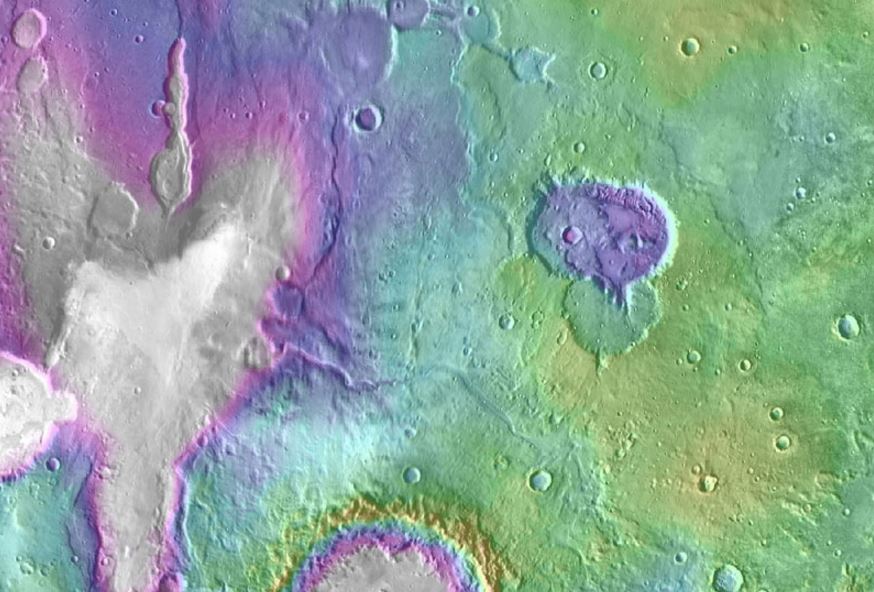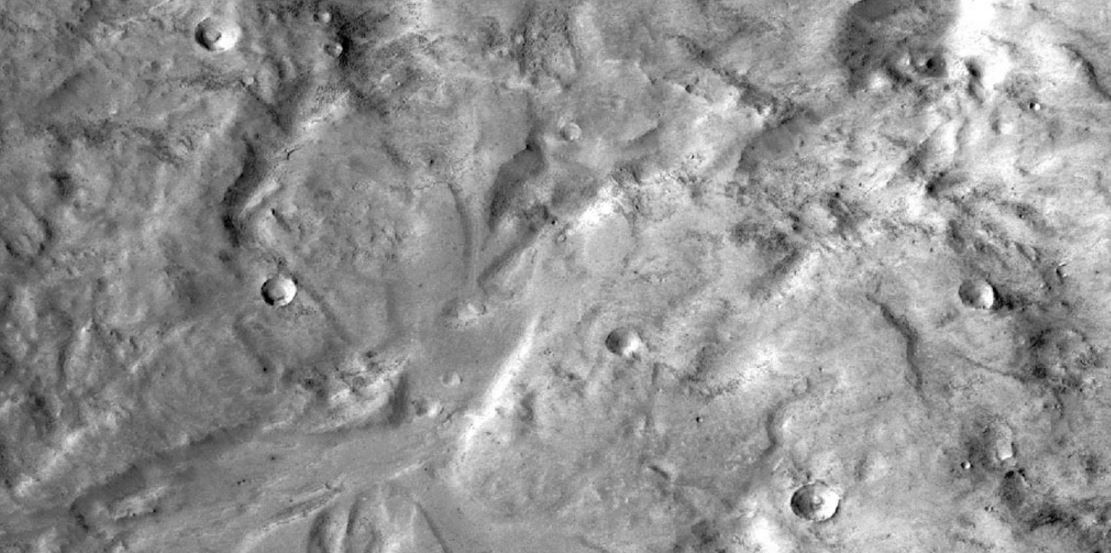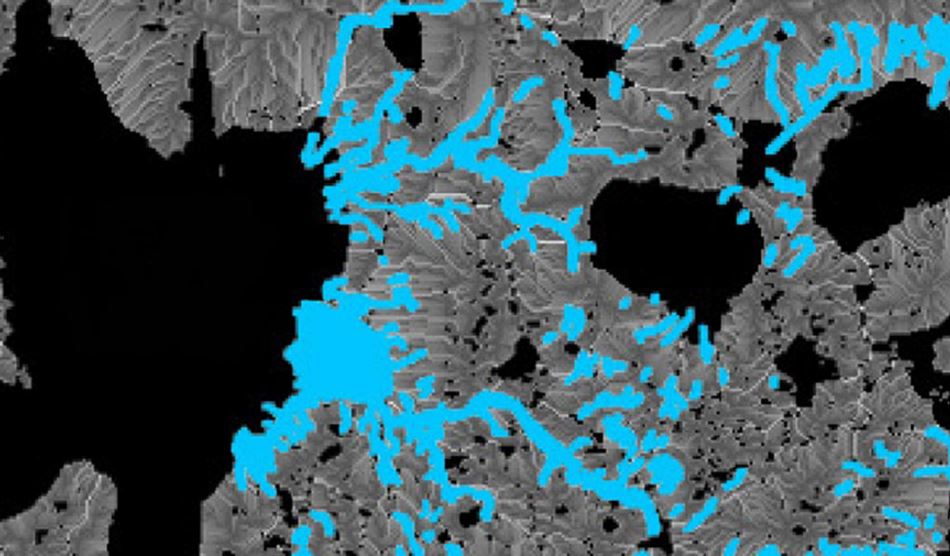Life on Mars, something scientists have been looking into for many years, has suddenly become dramatically more likely, after scientists discovered that lakes and snowmelt-fed streams on the Red Planet formed considerably later than had previously thought possible.
For there to be or have been life on Mars – life as we know it, that is – there had to be liquid water. It now appears that liquid water was around for at least one billion years longer than we had thought.
Gathering data primarily from NASA’s Mars Reconnaissance Orbiter, scientists explained in the Journal of Geophysical Research (citation below) that large areas of water on Mars existed for one billion years longer than we had estimated.
 The landscape in the northern Arabia Terra region in Mars – it includes a basin informally named ‘Heart Lake’ at upper left (northwest). If liquid water was around for 1 billion years longer, then the probability of there having been life on Mars has just shot up. (Image: jpl.nasa.gov)
The landscape in the northern Arabia Terra region in Mars – it includes a basin informally named ‘Heart Lake’ at upper left (northwest). If liquid water was around for 1 billion years longer, then the probability of there having been life on Mars has just shot up. (Image: jpl.nasa.gov)
Conditions for life on Mars were perhaps ideal
Their findings provide insight into the climate history of Mars and suggest that at a considerably later time, conditions may have been ideal for microbial life to exist.
Ms. Wilson, a graduate student, said:
“We discovered valleys that carried water into lake basins. Several lake basins filled and overflowed, indicating there was a considerable amount of water on the landscape during this time.”
The authors found evidence of these features in the Red Planet’s northern Arabia Terra region after analyzing images from the Mars Reconnaissance Orbiter’s Context Camera and High Resolution Imaging Science Experiment Camera. They also gathered and analyzed data from NASA’s Mars Global Surveyor and ESA’s (European Space Agency’s) Mars Express.
More water than Lake Ontario
Ms. Wilson compared one of Mars’ lakes to Lake Tahoe in California:
“One of the lakes in this region was comparable in volume to Lake Tahoe. This particular Martian lake was fed by an inlet valley on its southern edge and overflowed along its northern margin, carrying water downstream into a very large, water-filled basin we nicknamed ‘Heart Lake.'”
 Channel bars and streamlined forms in this Martian valley resulted from the outflow of a lake many hundreds of millions of years more recently than when we thought no liquid water existed on the Mars. (Image: jpl.nasa.gov)
Channel bars and streamlined forms in this Martian valley resulted from the outflow of a lake many hundreds of millions of years more recently than when we thought no liquid water existed on the Mars. (Image: jpl.nasa.gov)
Lake Tahoe holds approximately 188 cubic km (45 cubic miles) of water.
The series of valleys and lakes that form part of the Heart Lake valley system extends about 150 km (90 miles). Scientists calculate that Heart Lake held approximately 2,790 cubic km (670 cubic miles) of water, which is more than all the water in Lake Ontario of North America’s Great Lakes.
Ms. Wilson and colleagues – Alan Howard, from the University of Virginia, Jeffrey Moore, from the NASA Ames Research Center, and John Grant, from the Smithsonian Institution – mapped the extent of the stream-flow in ‘fresh shallow valleys’ and their associated former lakes.
The scientists suggest that the runoff that formed these valleys could have been seasonal.
To get a precise estimate of when the fresh shallow valleys of Arabia Terra formed, the team members started with age estimates for twenty-two impact craters in the area.
They assessed whether the valleys carved into the blankets surrounding the debris ejected from the craters, as an indicator of whether the valleys are younger or older than the craters.
They have concluded that this particularly wet period on Mars probably occurred between two and three billion years ago, which is at least one billion years after it is generally thought that most of the Red Planet’s original atmosphere had been lost and most of whatever water remained on the planet had frozen.
The valleys’ features support the interpretation that the climate was cold.
 A map showing where hydrologic modeling predicts locations of depressions that would have been lakes (in black), overlaid with a map of the preserved valleys (blue lines, made wider for recognition) that would have been streams. This area is within the Arabia Terra region. (Image: jpl.nasa.gov)
A map showing where hydrologic modeling predicts locations of depressions that would have been lakes (in black), overlaid with a map of the preserved valleys (blue lines, made wider for recognition) that would have been streams. This area is within the Arabia Terra region. (Image: jpl.nasa.gov)
Ms. Wilson said:
“The rate at which water flowed through these valleys is consistent with runoff from melting snow. These weren’t rushing rivers. They have simple drainage patterns and did not form deep or complex systems like the ancient valley networks from early Mars.”
The authors point out that similar valleys exist elsewhere on Mars between approximately 35 and 42 degrees latitude, both south and north of the equator. The similar appearance and widespread nature of these fresh, shallow valleys on the Red Planet suggest they formed across the whole planet rather than just on a local or regional scale.
Alan Howard said:
“A key goal for Mars exploration is to understand when and where liquid water was present in sufficient volume to alter the Martian surface and perhaps provide habitable environments.”
“This paper presents evidence for episodes of water modifying the surface on early Mars for possibly several hundred million years later than previously thought, with some implication that the water was emplaced by snow, not rain.”
What made conditions warm up?
Their findings will probably trigger more studies to determine how conditions warmed enough in that frozen world to allow an interval with flowing water. Perhaps there was an extreme change in Mars’ tilt, with more direct illumination of polar ice.
In an Abstract that preceded the journal’s main paper, the authors wrote:
“The widespread occurrence of FSVs (free shallow valleys) along with their similar morphology and shared modest state of degradation is consistent with most forming during a global interval of favorable climate, perhaps contemporaneous with alluvial fan formation in equatorial and mid-latitudes.”
“Evidence for a snowmelt based hydrology and considerable depths of water on the landscape in Arabia supports a cold, wet and possibly habitable environment late in Martian history.”
Citation: “A Cold-Wet Mid-Latitude Environment on Mars during the Hesperian-Amazonian Transition: Evidence from Northern Arabia Valleys and Paleolakes,” Sharon A. Wilson, Alan D. Howard, Jeffrey M. Moore & John A. Grant. Journal of Geophysical Research. Accepted manuscript online: 11 August 2016. DOI: 10.1002/2016JE005052.
Video – Methane spike on Mars detected
This Business Insider video tells us that NASA’s Curiosity rover detected methane on the Red Planet, which is usually produced by living organisms here on Earth. Does this increase there likelihood that there is life on Mars.
